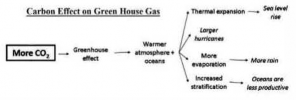17.3.1. Water vapour
Water vapour is the biggest overall contributor to the greenhouse effect and humans are not directly responsible for emitting this gas in quantities sufficient to change its concentration in the atmosphere. However, CO2 and other greenhouse gases is increasing the amount of water vapour in the air by boosting the rate of evaporation.
Unlike CO2, which can persist in the air for centuries, water vapour cycles through the atmosphere quickly, evaporating from the oceans and elsewhere before coming back down as rain or snow.
Since the rate of evaporation rises with temperature, the amount of water vapour in the air at any one time (and the amount of warming it causes) is strongly related to the amount of other greenhouse gases in the air.
17.3.2. CARBON DIOXIDE

♤ Carbon dioxide (CO2) is the primary greenhouse gas emitted through human activities. Carbon dioxide is naturally present in the atmosphere as part of the Earth’s carbon cycle (the natural circulation of carbon among the atmosphere, oceans, soil, plants, and animals).
♤ Human activities are altering the carbon cycle both by adding more CO2 to the atmosphere and by reducing the natural sinks, like deforestation, to remove CO2 from the atmosphere.
♤ While CO2 emissions come from a variety of natural sources, human-related emissions are responsible for the increase that has occurred in the atmosphere since the industrial revolution.
The main sources
i. The combustion of fossil fuels to generate electricity.
ii. The combustion of fossil fuels such as gasoline and diesel used for transportation.
iii. Many industrial processes emit CO2 through fossil fuel combustion.
iv. Several processes also produce CO2 emissions through chemical reactions that do not involve combustion, for example, the production and consumption of mineral products such as cement, the production of metals such as iron and steel, and the production of chemicals, etc.
Emissions and Trends
♤ Changes in CO2 emissions from fossil fuel combustion are influenced by many factors, including population growth, economic growth, changing energy prices, new technologies, changing behavior, and seasonal temperatures.
♤ Between 1990 and 2010, the increase in CO2 emissions corresponded with increased energy use by an expanding economy and population.
Do you know?
USA is the second largest Greenhouse Gas emitter presently. However, if cumulative historical emission is considered, USA would be a largest GHG emitter. So, its withdrawal will affect control of cumulative global GHG emissions. It will also affect the availability of international funds for climate change, as USA was a contributor to climate finance.
Reducing Carbon Dioxide Emissions
♤ The most effective way to reduce carbon dioxide (CO2) emissions is to reduce fossil fuel consumption. Other strategies include Energy Efficiency, Energy Conservation, Carbon Capture and Sequestration.
Do you know?
The pesticide industry in India, which is the fourth largest in the world and second largest in the Asia-Pacific region, only after China.
